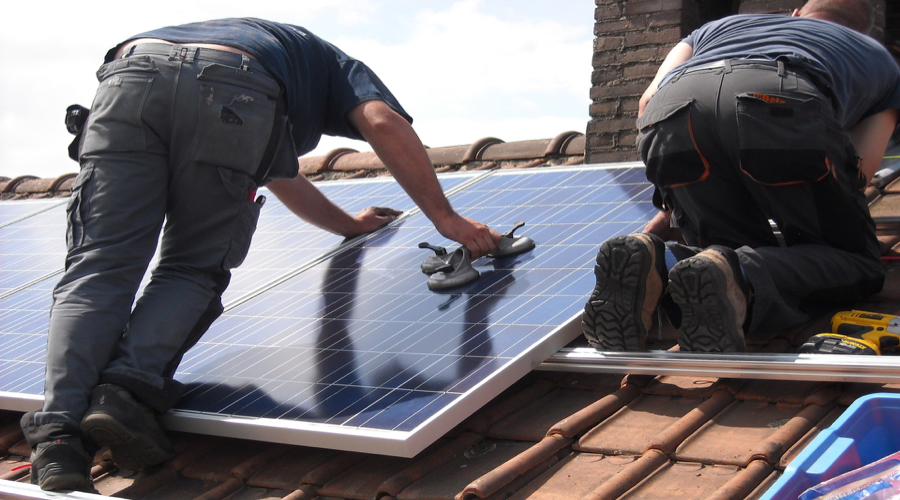Renewables beat coal as largest source of power capacity

While coal continues to crank out electricity for millions of people in developing nations, renewable energy is rapidly catching up and last year, overtook coal as the world’s largest source of installed power capacity.
About half a million solar panels were installed every day last year and two wind turbines went up ever hour in 2015 – which may be seen as a turning point for renewables, led by solar power and wind. The astonishing figures come via the International Energy Agency (IEA), which in a recent report, raised its renewable growth forecast.
In 2015 over half of new power capacity came from renewable energy – reaching 153 gigawatts, or 15% more than last year. The amount of solar and wind added in 2015 were both record-setting; PV additions reached 49 GW and wind achieved 66 GW.
About half a million solar panels were installed every day last year and two wind turbines went up ever hour in 2015
“There are many factors behind this remarkable achievement: more competition, enhanced policy support in key markets, and technology improvements. While climate change mitigation is a powerful driver for renewables, it is not the only one. In many countries, cutting deadly air pollution and diversifying energy supplies to improve energy security play an equally strong role in growing low-carbon energy sources, especially in emerging Asia,” states the latest edition of the IEA’s Medium-Term Renewable Market Report.
The 153 GW of installed green energy was more than the total power capacity of Canada and greater than the amount of conventional fossil fuel or nuclear power added in 2015. While renewables surpassed coal in their cumulative share of power capacity, they have not yet knocked fossil fuels from the top of the heap when it comes to electricity generation. That’s because renewables, due to their intermittency, cannot produce power at the same constant level as coal or nuclear.
According to the IEA in 2015 coal power plants produced close to 39% of the world’s power while renewables, including hydroelectric dams, accounted for 23%. However the IEA expects that number to climb to 28% by 2021, when renewables will supply the equivalent of all the power produced currently in the US and the EU combined.
The IEA now sees renewables growing 13% more between 2015 and 2021 than it did in last year’s forecast, due mostly to “stronger policy backing in the United States, China, India and Mexico.” The costs of installing solar and wind have dropped, and expected to drop considerably – 25% less for PV solar and a decrease of 15% for onshore wind, for the forecasted period, according to the agency.
More News
{{ commodity.name }}
{{ post.title }}
{{ post.date }}



9 Comments
Dan
Another shameless lie by omitting essential information: first of all, it is obvious that the main reason “renewables” have such a large share of new installations (and I exclude here the classic hydro, which is a legitimate power source), are the governments in the “developed” countries which enforced absurd regulations which led to the closure of more and more coal power plants. At the same time these idiotic melon ideologues granted enormous subsidies for “renewables”, of course paid by with taxpayers monies (without asking of course the taxpayers). Communist countries tried to do the same red ideological planning with their economies and they all collapsed. Any analysis of the “renewables” impact should include the real electricity delivered to consumer vs installed power (and compared to electricity delivered by the old coal power plants). Also how much “renewables” generated electricity cost the consumer vs coal produced electricity. The outcome of this ideological driven destruction of the cheap electricity production in the “developed” world will be exactly the same outcome as for the planned communist economies – collapse , rather sooner than later. When high electricity pricing and total blackouts make any productive industry non-competitive – meaningful jobs disappear and with them the lifestyle our generation got used to. Meantime our governments get less and less tax which mean they increase taxes on those still working , which mean less and less productive work happening. Meantime, China and other smart asian countries import coal to produce cheap electricity and continue to develop at a high pace and enrich their populations. I grew up in a communist country and I know how a centrally planned economy works (we were miming that we worked, the government was mimin paying us). Welcome to the future: total blackouts already started in the “green” South Australia. These new generations of indoctrinated greenoid lambs do not even have an idea what awaits them.
Matt Robinson
This actually isn’t good news for renewables at all, because by the admission of this self-same Agency, renewables will account for barely a third of electricity generation even as far out as 2040.
It’s clear testimony to the ineffectiveness of renewables to generate electricity to the scale needed to meet worldwide demand.
When you take into account the expected habitat loss due to land clearing, the mining for the resources, and the short lifespan, renewables are an environmental DISASTER:
https://www.eia.gov/forecasts/ieo/electricity.cfm
https://uploads.disquscdn.com/images/fb57424b2dd4a19083fe83d445ab9ff50950406e6c179dc7523ab5992c175fe7.png
JohnH
Good points Dan.
The author skips around the fact that he/she/it are writing about new capacity.
Total installed – renewables might make 20% in some places. When someone finally figures out that reneables don’t work at night or if the wind doesn’t blow, or blows too hard.
So its not just the installed cost of renewables, its the holding cots of gas/fuel, plant spare grid capacity for the days when all hell beaks loose
Who is the first to complain when they have high connection charges? The “..and I ain’t usin’ none. I makes me own” characters who expect to only pay for the 2-5 days they use it, not the 360-363 days they expect someone else to pay.
The illusion is people think its sunny every day and the wind blows all the time and its free. Just like the internet mentality. They forget the 6 hours of evening use when its dark and the two hours in the morning when the winds are usually weak and sun is low.
BATTERIES! Done deal. Problem solved. Errrr.. who’s paying? Dumb attention seeking politicians, and dumber population. Churchill said “The best argument against democracy is a five-minute conversation with the average voter..”
Mike Failla
I notice that without government subsidies that solar and wind fall flat on their faces.That props them up. When they can compete without subsidies then it can truly compete head to head then lets talk.
J. D. Baker
Lets put this in perspective.
Per confirmed 2015 electic generation data for USA, U.S. EIA reports as follows:
In 2015, the United States generated about 4 trillion kilowatthours of electricity.
About 67% of the electricity generated was from fossil fuels (coal, natural gas, and petroleum).
Major energy sources and percent share of total U.S. electricity generation in 2015:
Coal = 33%
Natural gas = 33%
Nuclear = 20%
Hydropower = 6%
Other renewables = 7%
Biomass = 1.6%
Geothermal = 0.4%
Solar = 0.6%
Wind = 4.7%
Petroleum = 1%
Other gases = <1%
J. D. Baker
Above article buries important caveat provided in the cited source data.
Namely, “but while 2015 was an exceptional year, there are still grounds for caution.”
Indeed. So, let’s cover some specifics, shall we?
1. Policy uncertainty persists in too many countries, slowing down the pace of investments.
Translation: renewable energy “green priests” believe countries are not being aggressive enough in mandating and subsidizing renewable energy; further, they want long term mandatory support and legislation to favor renewables (regardless of actual economics).
2. Rapid progress in variable renewables such as wind and solar PV is also exacerbating system integration issues in a number of markets.
Translation: intermittent, variable electric power generation (i.e., wind and solar) have additional costs and disadvantages that are typically ignored by renewable advocates but are critically important for power grids, distribution and demand.
3. Cost of financing remains a barrier in many developing countries.
Translation: for developing countries dependent on international financing for power generation, rigorous economic evaluation doesn’t typically favor renewables, especially wind and solar.
4. Progress in renewable growth in both heat and transport sectors remains slow.
Translation: heating demand favors reliable, continuous supply whereas (for obvious reasons) solar and wind cannot displace conventional baseload (continuous) power generation without operating subsidies and viable power storage. Also, transport sector remains firmly tied to fossil fuel for obvious reasons: we don’t have economically viable solar powered commercial air (planes and jets) and marine (freight, bulk, etc.) and ground transport either uses fossil fuel directly or primarily relies on fossil fuels indirectly.
Gary
I agree with all of your comments. Having suffered in South Australia for nearly 3 days without power, due in essence to the state governments reliance on renewable energy, all I can see is a candle light at the end of the tunnel.
Renewable energy like climate change has become a religion unfortunately (And I have solar panels on my roof!)
Kenneth Viney
What a bunch of liberal progressive crap.
Be
I’m sorry, the IEA projections are a joke. They have been laughably ridiculously wrong in the past,, and even their projection now, are already achieved today. The IEA was formed to protect oil reserve, they are a very biased agency. https://climatecrocks.com/2014/11/26/energy-establishment-stupendously-spectacularly-chronically-woefully-comically-wrong-on-energy-trends/
Solar and wind can supply MORE of our the grid energy than baseload nuclear and coal which don’t throttle. The inflexibility limits coal and nuclear to less than 50% of the total energy, the rest has to be supply by reserve and peak fossils power generators, the very same generator that solar and wind use. Germany and Denmark go from 0 renewable to 100% renewable in hours and they have the world’s most reliable grid, 10 times better than the USA. Solar and wind are now avaible the cheapest of all energy sources before gov breaks (Lazard enegy version 9) and installed capacity has double ever 1.8 years and 3.2 years in the last ten years. At that rate the world will have more than enough solar and wind in 15 years, and it will be backed with hydro and fuel from wastes in those reserve generators. It’s not a problem. The market is forcing it.